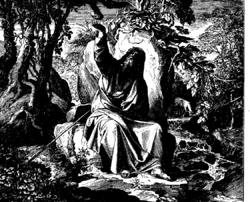Chorath
Topic: Earth
 From HandWiki - Reading time: 4 min
From HandWiki - Reading time: 4 min
Cherith, Kerith (Hebrew: נַחַל כְּרִית Naḥal Kərīṯ), or sometimes Chorath (/ˈkɔːrɑːθ/; from the Septuagint's Greek: Χειμάῤῥους Χοῤῥάθ cheimárrhous Chorrháth), is the name of a wadi, or intermittent seasonal stream[1] mentioned in the Hebrew Bible.[2][3][4][5][6][7][8][9] The prophet Elijah hid himself on the banks of the Cherith and was fed by ravens during the early part of the three years' drought which he announced to King Ahab (1 Kings 17:3).
Etymology and toponymy
Cherith is a common English spelling of the Hebrew name כְּרִית "Kərīṯ", that comes from the Hebrew root כרת (kh*r*t) meaning to cut off or cut down.[10][11] The name also signifies to engrave or carve, a cutting, separation, gorge, torrent-bed, or winter-stream.[citation needed]
Chorath is the name used in the 3rd-century BCE Greek translation of the Torah or Pentateuch, known as the Septuagint.[citation needed]
Cherith is referred to as a nahal in Hebrew (נחל, naḥal), a seasonal stream often described in a MENA context as a wadi, from the Arabic term وادي (wādī).[citation needed]
Identification
Wadi al-Yabis
It is usually identified with Wadi al-Yabis, a stream in western Jordan, which flows into the Jordan River at a spot opposite of Beit She'an and slightly south of it.[12] Travellers have described it as one of the wildest ravines of the Fertile Crescent, and peculiarly fitted to afford a secure asylum to the persecuted. During the summer, the stream is very dry.[13] Olive trees grow on its banks, and it is home to an array of wildlife including gazelle, hyrax, and egret.[14]
According to the 1994 Peace treaty between Israel and Jordan, Israel can maintain its use of the Jordan River waters between the Yarmouk and Wadi al-Yabis.[15][16]
Wadi Kelt
Alternatively, the stream Cherith has been identified by some with Wadi Kelt at St. George's Monastery.[17] If 1 Kings 17:3 is to be translated "Wadi Cherith, which is east of the Jordan", this identification would be in contradiction to the Bible, since Wadi Qelt is west of it. The King James version states Elijah should "turn eastward" (from Samaria); therefore the brook could be anywhere east of Samaria (now Sebastia, West Bank), on either side of the River Jordan.[18] Some translations (i.e. the Orthodox Jewish Bible: [1]) allow such an interpretation, by stating that Cherith is merely "near the Yarden" (Yarden being the Hebrew name of the River Jordan).
Wadi Fusail
Conder and Kitchener noted, while writing of Qaryut, that "[t]his place, being at the head of Wady Fusail, seems to have given rise to the mediaeval identification of that valley as the Brook Cherith (mentioned by Marino Sanuto in 1321)."[19] Sanuto commented that the stream extended into Phasaelis, which was named after Prince Phasael, the brother of King Herod.[20] This identification would again contradict the more common translation of 1 Kings 17:3 (see comment above at "Wadi Kelt"), since Wadi Fusail with both modern Qaryut and ancient Phasaelis lie west, not east of the Jordan.
Other uses of the name
The name is also a Mizrahi Jewish surname, specifically among Jews of Yemenite extraction. They descend from the tribe of Bnei Chorath (Hebrew version of Arabic Banu al-Harith), which is of Qahtanite origin and was once one of the most important tribes of the city of Najran.[21]
References
- ↑ Frederick Fyvie Bruce, The Gospel of John: Introduction, Exposition, Notes, p. 339. Eerdmans, 3rd edition (1994)
- ↑ "A dictionary of the Bible; comprising its antiquities, biography, geography, and natural history". Che'rith, the brook. http://www.ebooksread.com/authors-eng/drayton-griffin-and-smith/a-dictionary-of-the-bible-comprising-its-antiquities-biography-geography-and-678/page-78-a-dictionary-of-the-bible-comprising-its-antiquities-biography-geography-and-678.shtml.
- ↑ Keller, David (2011). Desert Banquet: A Year of Wisdom from the Desert Mothers and Fathers.
- ↑ Waheeb, M. (2012). "The Discovery of Elijah's Hill and John's Site of the Baptism, East of the Jordan River from the Description of Pilgrims and Travellers". Asian Social Science 8 (8). doi:10.5539/ass.v8n8p200.
- ↑ Fitzgerald, S. (2010). "Apostolic Geography: The Origins and Continuity of a Hagiographic Habit". Dumbarton Oaks Papers (64): 5–25. https://www.academia.edu/1498053.
- ↑ "The Life Of John The Elder And The Cave Of Sapsas". St. Luke the Evangelist Greek Orthodox Church. http://saintlukecolumbia.org/orthodoxy-articles/2011/3/28/the-life-of-john-the-elder-and-the-cave-of-sapsas.html. Retrieved 18 September 2014.
- ↑ "The Peraea and the Dead Sea". The Madaba Mosaic Map. http://www.christusrex.org/www1/ofm/mad/sources/sources017.html. Retrieved 26 August 2011.
- ↑ Johnson, Scott Fitzgerald (2016). Literary Territories: Cartographical Thinking in Late Antiquity.
- ↑ Pustet, Anton (1901). Studien und Mitteilungen zur Geschichte des Benediktinerordens und seiner Zweige.
- ↑ Kerith on Bible Hub, "Word Origin: from karath"
- ↑ Definition of karath, New American Standard: Exhaustive Concordance of the Bible via Bible Hub
- ↑ Armstrong, George (1895). Names and places in the Old and New Testament and apocrypha: With their modern identifications.
- ↑ Easton, Matthew George (1897). The Bible Dictionary: Your Biblical Reference Book (1st ed.). Thomas Nelson. ISBN 9780933186590. https://archive.org/details/eastonsbibledict00east.
- ↑ "The Peraea and the Dead Sea". Jordan Beauty. http://www.jordanbeauty.com/WadiAl-Yabis.html. Retrieved 19 August 2012.
- ↑ Israel Ministry of Foreign Affairs, Israel-Jordan Peace Treaty Annex II, Article 2.3, accessed 30 October 2017
- ↑ Shapland, Greg (1997). Rivers of Discord: International Water Disputes in the Middle East (1st ed.).
- ↑ "The Life Of John The Elder And The Cave Of Sapsas". St. Luke the Evangelist Greek Orthodox Church. http://saintlukecolumbia.org/orthodoxy-articles/2011/3/28/the-life-of-john-the-elder-and-the-cave-of-sapsas.html. Retrieved 9 July 2016.
- ↑ King James Bible; 1 Kings 17:3
- ↑ Conder, C.R.; Kitchener, H.H. (1882). The Survey of Western Palestine: Memoirs of the Topography, Orography, Hydrography, and Archaeology. 2. London: Committee of the Palestine Exploration Fund. p. 288. https://archive.org/stream/surveyofwesternp02conduoft#page/288/mode/1up. Retrieved 7 July 2021.
- ↑ Armstrong, George (1895). Names and places in the old and new testament and apocrypha: With their modern identifications.
- ↑ Norman A. Stillman, The Jews of Arab lands: A history and source book, p. 117
 |
 KSF
KSF
